Abstract
1. The responsiveness of the stretch reflex is modulated during human voluntary limb movements. The influence of this modulation on the limb mechanical properties (stiffness) was investigated. 2. Subjects were taught to replicate accurately a rapid (4.0 rad s-1) targeted elbow flexion movement of 1 rad. From the onset of 12% of the trials a sinusoidal position disturbance (0.05 rad) was superimposed on the normal (trained) movement trajectory. The net joint torque (muscle torque) resisting these stretches was computed from measurements of applied torque, acceleration and limb inertia. Electromyographic (EMG) responses in the triceps brachii (TB), brachialis (Br) and biceps brachii (BB) were monitored. 3. The EMG responses to sinusoidal stretches applied early in the movement were less than those responses to perturbations applied when the arm neared the target (especially in the antagonist muscle TB). These EMG responses caused fluctuations in the resistance to the perturbation (stiffness), as described below. 4. When the perturbation frequency was low (< 4 Hz) the resistance of the elbow muscles to the stretch increased as the arm approached the target (48% increase). In contrast, when the stretch frequency was 7 Hz the resistance decreased by 63%. This decrease can be explained by the increased reflex response, since at 7 Hz the reflex response is probably timed so that it assists, rather than resists, the stretching as a result of loop delays. This reflex timing was confirmed by observing that, after abruptly stopping the sinusoidal stretch, the reflex response persisted for 100 ms and was indeed in a direction that would have reduced the resistance, had the perturbation continued. 5. The time course of the net muscle stiffness was estimated for frequencies ranging from 4 to 8 Hz and for each 40 ms interval a Nyquist plot was constructed, forming a C-shaped curve as frequency was varied. The size of this curve gave a measure of the stiffness resulting from reflex activity. When the arm neared the target this reflexive stiffness reached a maximum, and was probably comparable in size to the intrinsic (non-reflexive) muscle stiffness. Also, in four of the five subjects the viscous component of stiffness at 7 Hz dropped significantly below zero when the arm neared the target, again indicating that at this frequency the reflex was large and acted inappropriately.(ABSTRACT TRUNCATED AT 400 WORDS)
Full text
PDF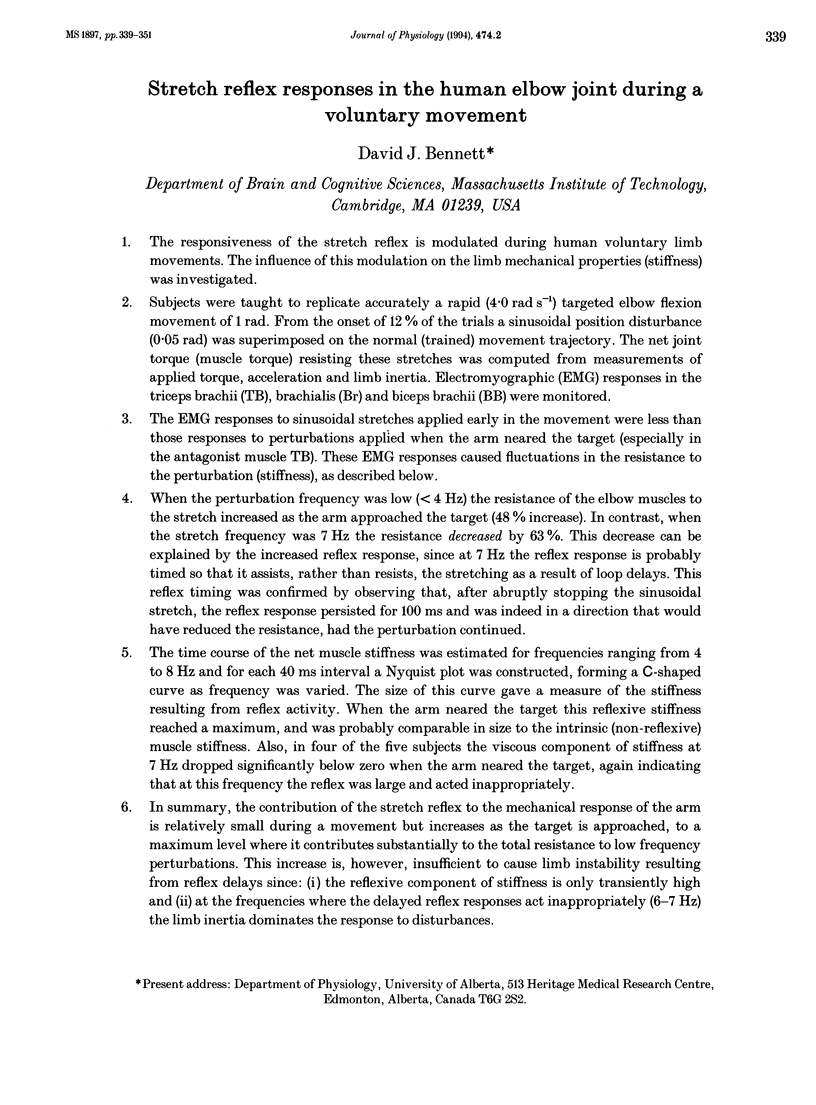
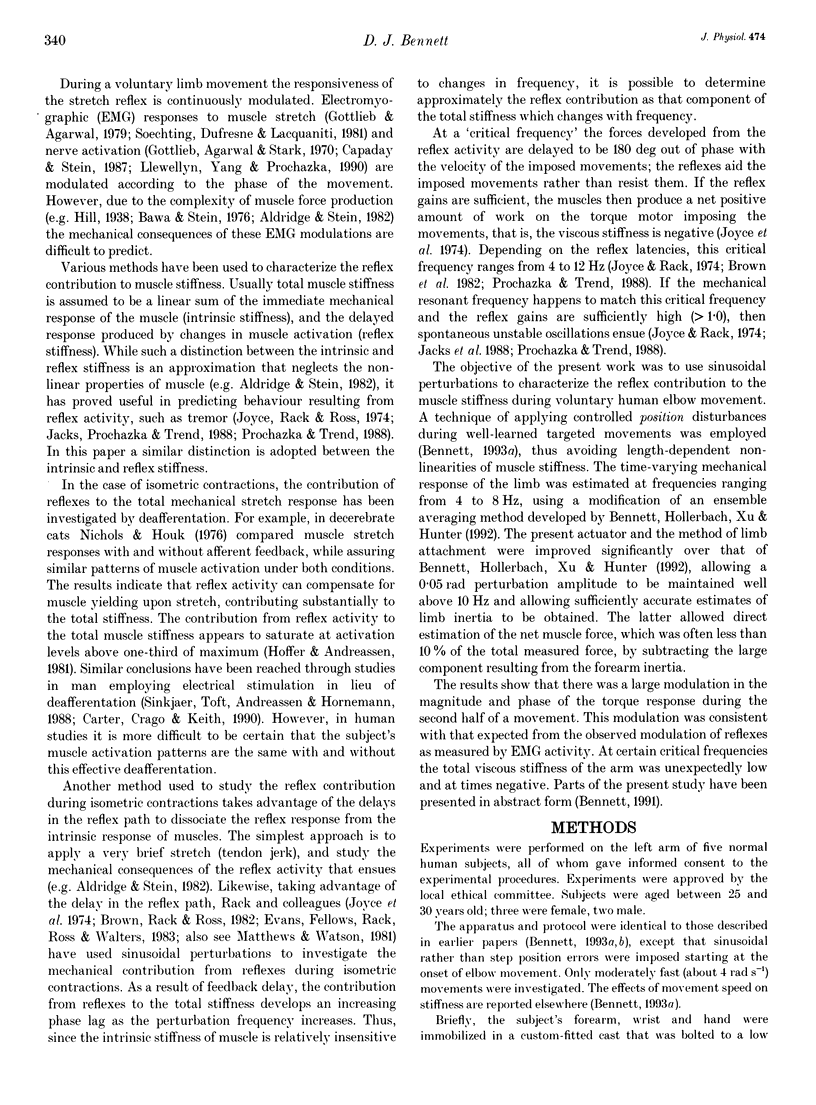
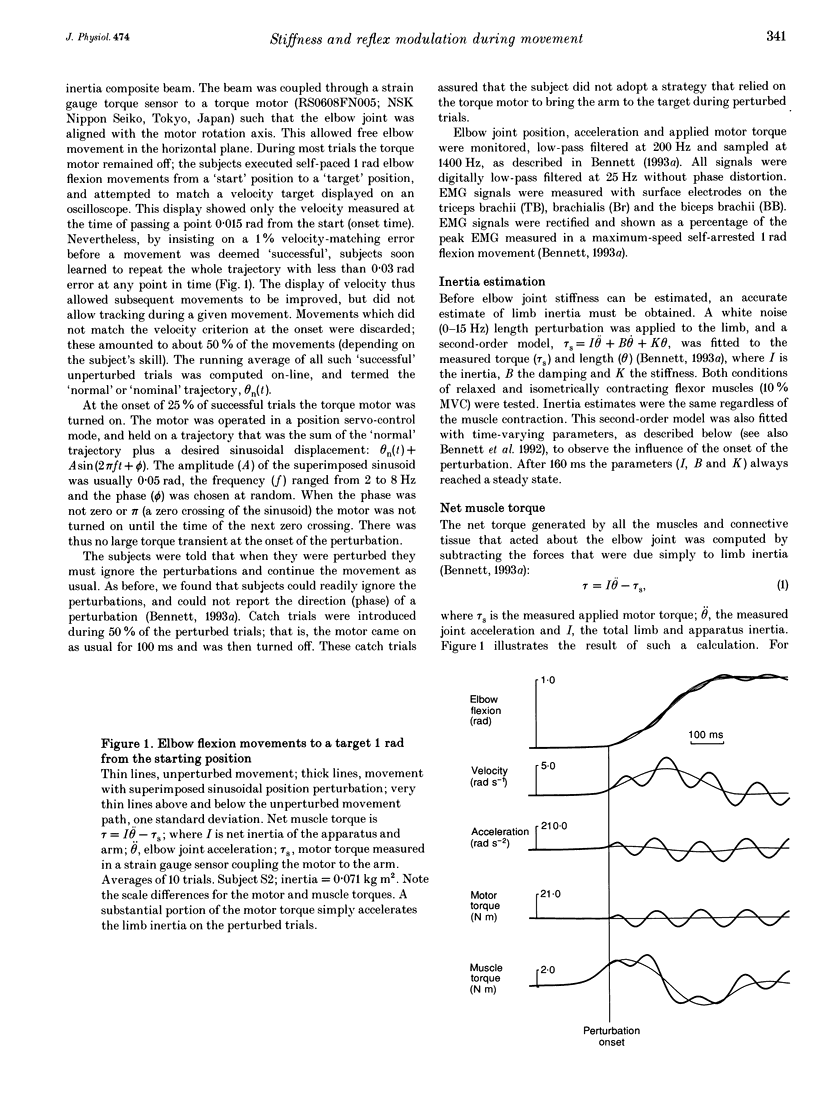
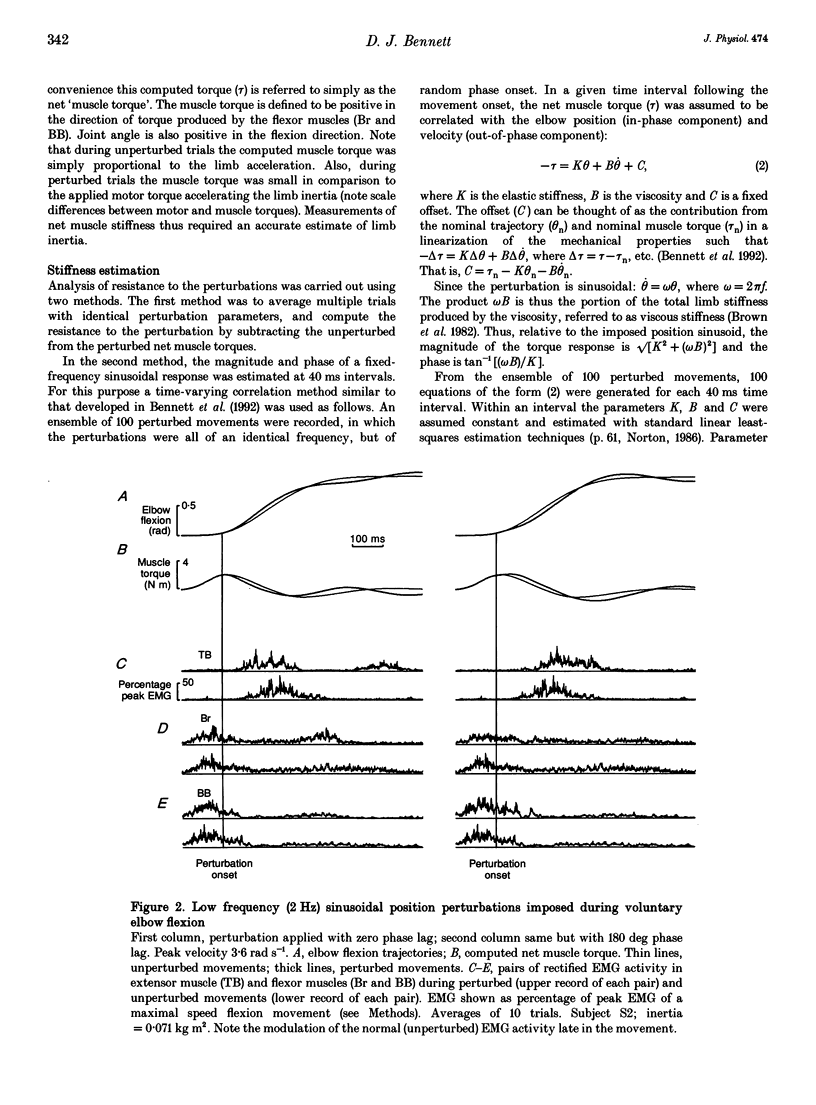
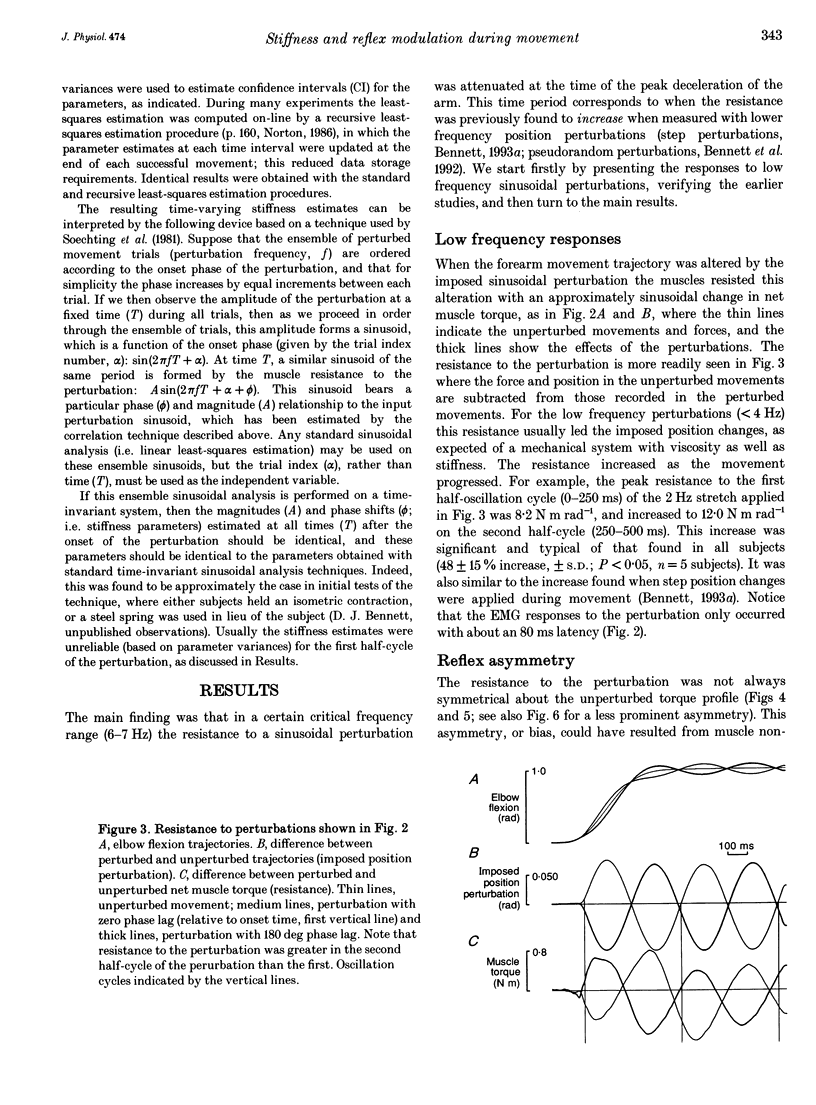

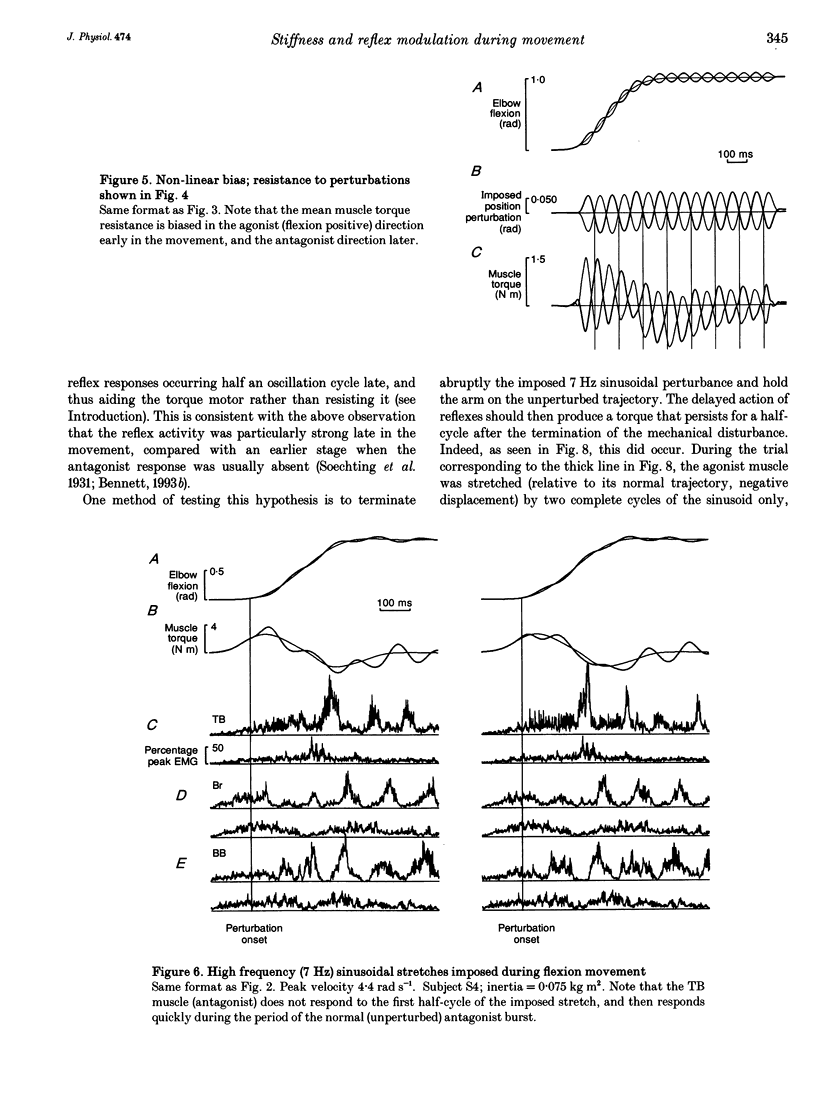
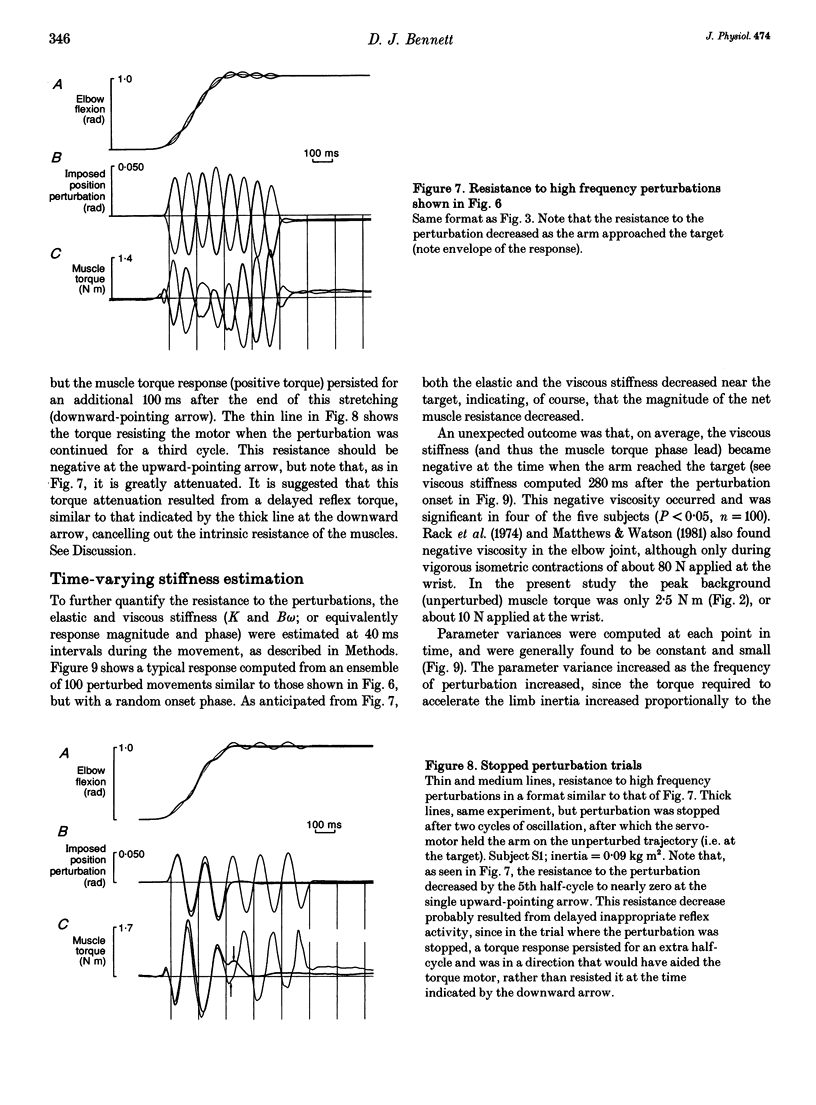
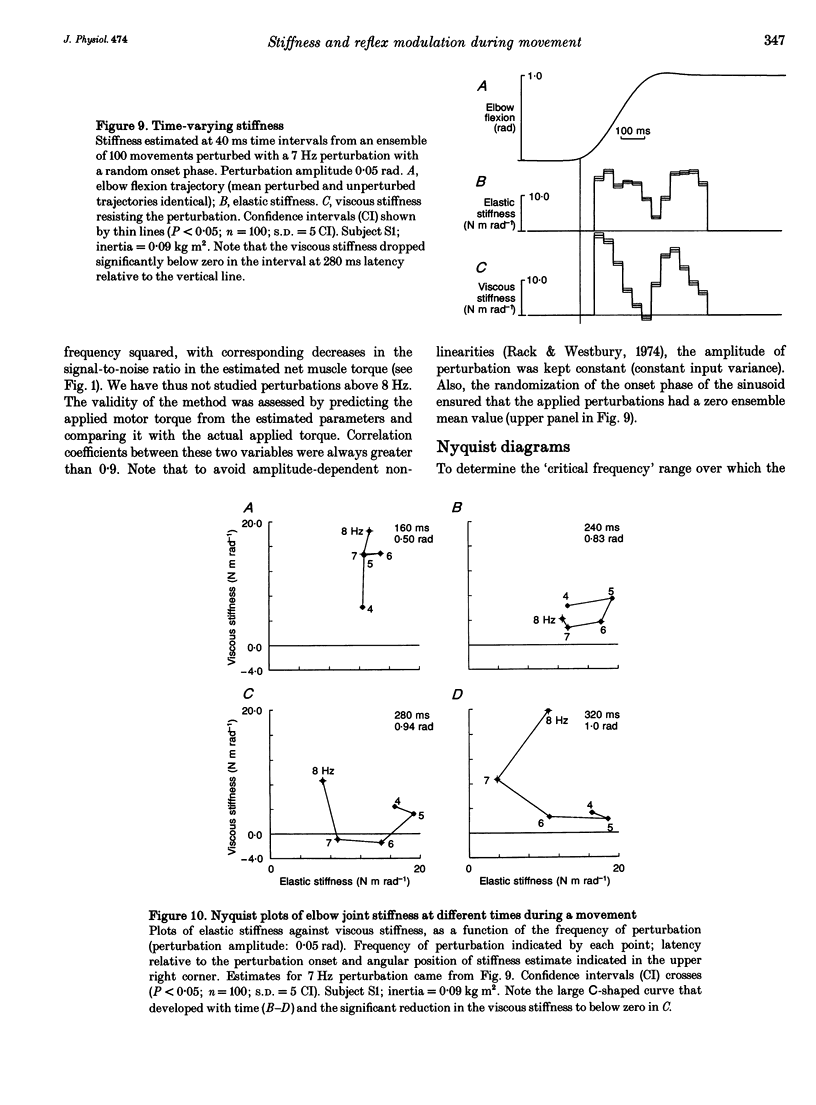
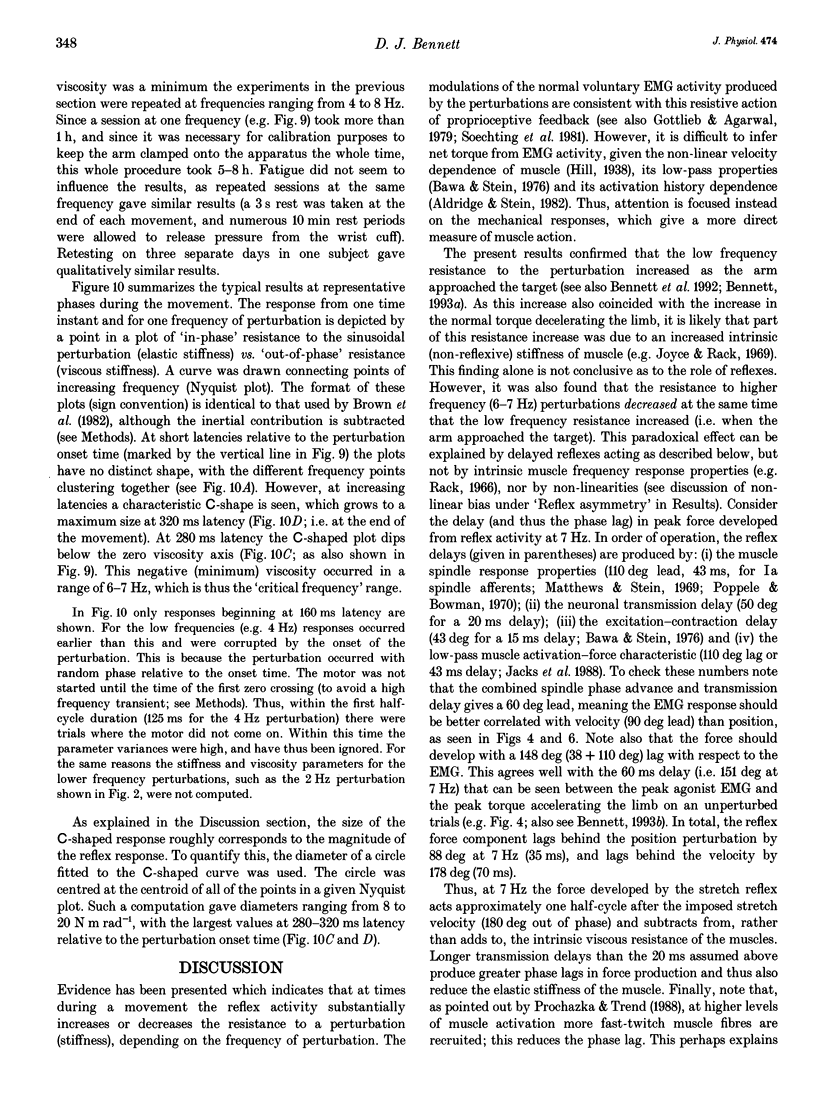
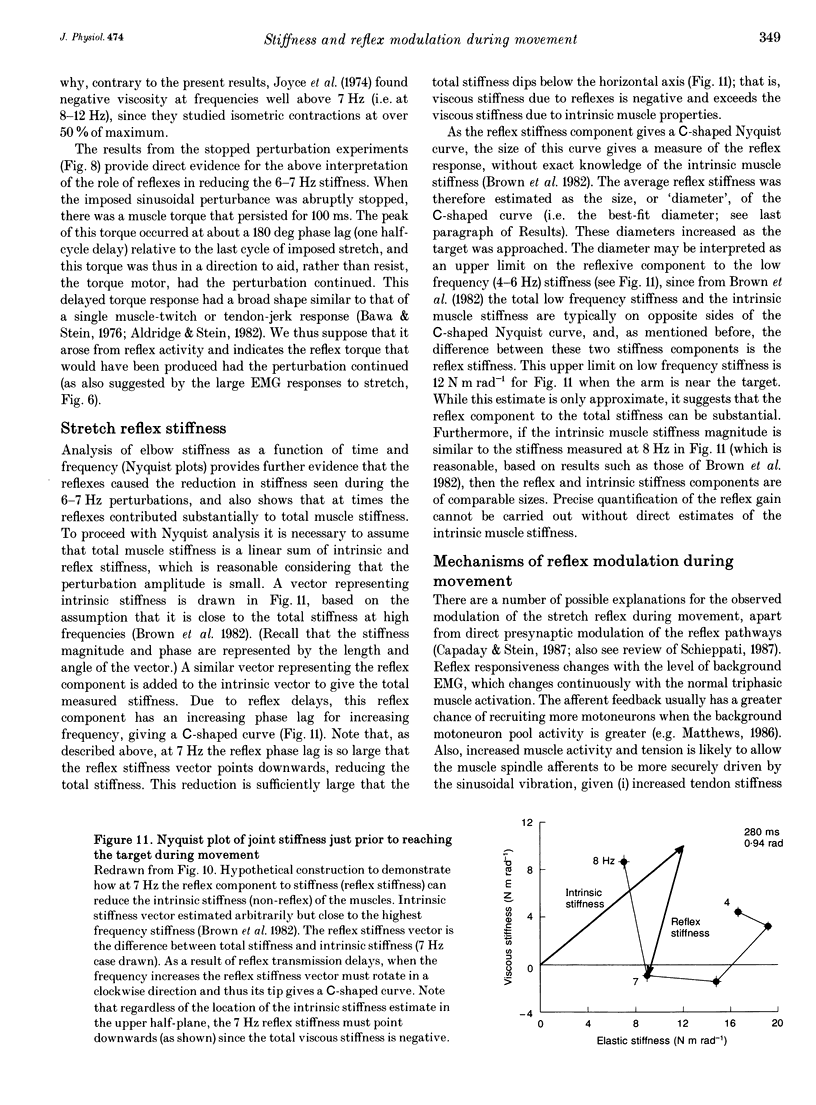
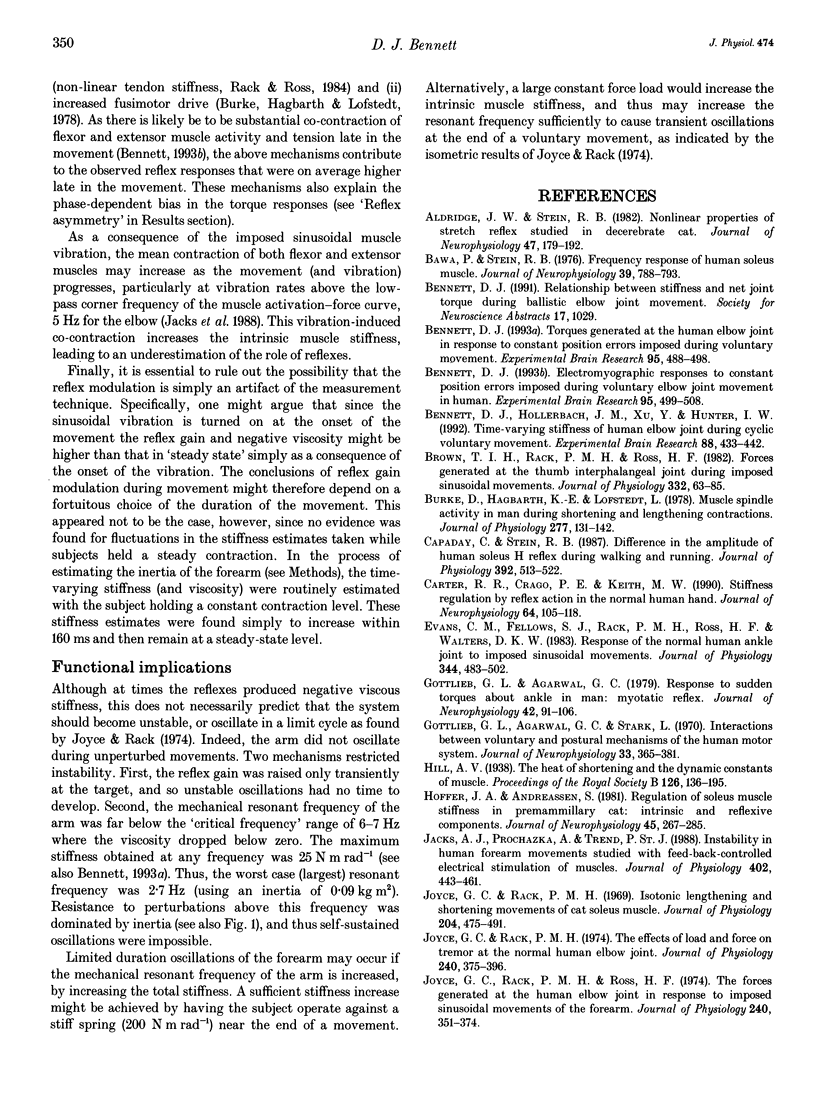

Selected References
These references are in PubMed. This may not be the complete list of references from this article.
- Aldridge J. W., Stein R. B. Nonlinear properties of stretch reflex studied in the decerebrate cat. J Neurophysiol. 1982 Feb;47(2):179–192. doi: 10.1152/jn.1982.47.2.179. [DOI] [PubMed] [Google Scholar]
- Bawa P., Stein R. B. Frequency response of human soleus muscle. J Neurophysiol. 1976 Jul;39(4):788–793. doi: 10.1152/jn.1976.39.4.788. [DOI] [PubMed] [Google Scholar]
- Bennett D. J. Electromyographic responses to constant position errors imposed during voluntary elbow joint movement in human. Exp Brain Res. 1993;95(3):499–508. doi: 10.1007/BF00227143. [DOI] [PubMed] [Google Scholar]
- Bennett D. J., Hollerbach J. M., Xu Y., Hunter I. W. Time-varying stiffness of human elbow joint during cyclic voluntary movement. Exp Brain Res. 1992;88(2):433–442. doi: 10.1007/BF02259118. [DOI] [PubMed] [Google Scholar]
- Bennett D. J. Torques generated at the human elbow joint in response to constant position errors imposed during voluntary movements. Exp Brain Res. 1993;95(3):488–498. doi: 10.1007/BF00227142. [DOI] [PubMed] [Google Scholar]
- Brown T. I., Rack P. M., Ross H. F. Forces generated at the thumb interphalangeal joint during imposed sinusoidal movements. J Physiol. 1982 Nov;332:69–85. doi: 10.1113/jphysiol.1982.sp014401. [DOI] [PMC free article] [PubMed] [Google Scholar]
- Burke D., Hagbarth K. E., Löfstedt L. Muscle spindle activity in man during shortening and lengthening contractions. J Physiol. 1978 Apr;277:131–142. doi: 10.1113/jphysiol.1978.sp012265. [DOI] [PMC free article] [PubMed] [Google Scholar]
- Capaday C., Stein R. B. Difference in the amplitude of the human soleus H reflex during walking and running. J Physiol. 1987 Nov;392:513–522. doi: 10.1113/jphysiol.1987.sp016794. [DOI] [PMC free article] [PubMed] [Google Scholar]
- Carter R. R., Crago P. E., Keith M. W. Stiffness regulation by reflex action in the normal human hand. J Neurophysiol. 1990 Jul;64(1):105–118. doi: 10.1152/jn.1990.64.1.105. [DOI] [PubMed] [Google Scholar]
- Evans C. M., Fellows S. J., Rack P. M., Ross H. F., Walters D. K. Response of the normal human ankle joint to imposed sinusoidal movements. J Physiol. 1983 Nov;344:483–502. doi: 10.1113/jphysiol.1983.sp014953. [DOI] [PMC free article] [PubMed] [Google Scholar]
- Gottlieb G. L., Agarwal G. C. Response to sudden torques about ankle in man: myotatic reflex. J Neurophysiol. 1979 Jan;42(1 Pt 1):91–106. doi: 10.1152/jn.1979.42.1.91. [DOI] [PubMed] [Google Scholar]
- Gottlieb G. L., Agarwal G. C., Stark L. Interactions between voluntary and postural mechanisms of thehuman motor system. J Neurophysiol. 1970 May;33(3):365–381. doi: 10.1152/jn.1970.33.3.365. [DOI] [PubMed] [Google Scholar]
- Hoffer J. A., Andreassen S. Regulation of soleus muscle stiffness in premammillary cats: intrinsic and reflex components. J Neurophysiol. 1981 Feb;45(2):267–285. doi: 10.1152/jn.1981.45.2.267. [DOI] [PubMed] [Google Scholar]
- Jacks A., Prochazka A., Trend P. S. Instability in human forearm movements studied with feed-back-controlled electrical stimulation of muscles. J Physiol. 1988 Aug;402:443–461. doi: 10.1113/jphysiol.1988.sp017214. [DOI] [PMC free article] [PubMed] [Google Scholar]
- Joyce G. C., Rack P. M. Isotonic lengthening and shortening movements of cat soleus muscle. J Physiol. 1969 Oct;204(2):475–491. doi: 10.1113/jphysiol.1969.sp008925. [DOI] [PMC free article] [PubMed] [Google Scholar]
- Joyce G. C., Rack P. M., Ross H. F. The forces generated at the human elbow joint in response to imposed sinusoidal movements of the forearm. J Physiol. 1974 Jul;240(2):351–374. doi: 10.1113/jphysiol.1974.sp010614. [DOI] [PMC free article] [PubMed] [Google Scholar]
- Joyce G. C., Rack P. M. The effects of load and force on tremor at the normal human elbow joint. J Physiol. 1974 Jul;240(2):375–396. doi: 10.1113/jphysiol.1974.sp010615. [DOI] [PMC free article] [PubMed] [Google Scholar]
- Joyce G. C., Rack P. M., Westbury D. R. The mechanical properties of cat soleus muscle during controlled lengthening and shortening movements. J Physiol. 1969 Oct;204(2):461–474. doi: 10.1113/jphysiol.1969.sp008924. [DOI] [PMC free article] [PubMed] [Google Scholar]
- Llewellyn M., Yang J. F., Prochazka A. Human H-reflexes are smaller in difficult beam walking than in normal treadmill walking. Exp Brain Res. 1990;83(1):22–28. doi: 10.1007/BF00232189. [DOI] [PubMed] [Google Scholar]
- Matthews P. B. Observations on the automatic compensation of reflex gain on varying the pre-existing level of motor discharge in man. J Physiol. 1986 May;374:73–90. doi: 10.1113/jphysiol.1986.sp016066. [DOI] [PMC free article] [PubMed] [Google Scholar]
- Matthews P. B., Stein R. B. The sensitivity of muscle spindle afferents to small sinusoidal changes of length. J Physiol. 1969 Feb;200(3):723–743. doi: 10.1113/jphysiol.1969.sp008719. [DOI] [PMC free article] [PubMed] [Google Scholar]
- Matthews P. B., Watson J. D. Effect of vibrating agonist or antagonist muscle of the reflex response to sinusoidal displacement of the human forearm. J Physiol. 1981 Dec;321:297–316. doi: 10.1113/jphysiol.1981.sp013985. [DOI] [PMC free article] [PubMed] [Google Scholar]
- Nichols T. R., Houk J. C. Improvement in linearity and regulation of stiffness that results from actions of stretch reflex. J Neurophysiol. 1976 Jan;39(1):119–142. doi: 10.1152/jn.1976.39.1.119. [DOI] [PubMed] [Google Scholar]
- Prochazka A., Trend P. S. Instability in human forearm movements studied with feed-back-controlled muscle vibration. J Physiol. 1988 Aug;402:421–442. doi: 10.1113/jphysiol.1988.sp017213. [DOI] [PMC free article] [PubMed] [Google Scholar]
- Rack P. M., Ross H. F. The tendon of flexor pollicis longus: its effects on the muscular control of force and position at the human thumb. J Physiol. 1984 Jun;351:99–110. doi: 10.1113/jphysiol.1984.sp015235. [DOI] [PMC free article] [PubMed] [Google Scholar]
- Rack P. M. The behaviour of a mammalian muscle during sinusoidal stretching. J Physiol. 1966 Mar;183(1):1–14. doi: 10.1113/jphysiol.1966.sp007848. [DOI] [PMC free article] [PubMed] [Google Scholar]
- Rack P. M., Westbury D. R. The short range stiffness of active mammalian muscle and its effect on mechanical properties. J Physiol. 1974 Jul;240(2):331–350. doi: 10.1113/jphysiol.1974.sp010613. [DOI] [PMC free article] [PubMed] [Google Scholar]
- Schieppati M. The Hoffmann reflex: a means of assessing spinal reflex excitability and its descending control in man. Prog Neurobiol. 1987;28(4):345–376. doi: 10.1016/0301-0082(87)90007-4. [DOI] [PubMed] [Google Scholar]
- Sinkjaer T., Toft E., Andreassen S., Hornemann B. C. Muscle stiffness in human ankle dorsiflexors: intrinsic and reflex components. J Neurophysiol. 1988 Sep;60(3):1110–1121. doi: 10.1152/jn.1988.60.3.1110. [DOI] [PubMed] [Google Scholar]
- Soechting J. F., Dufresne J. R., Lacquaniti F. Time-varying properties of myotatic response in man during some simple motor tasks. J Neurophysiol. 1981 Dec;46(6):1226–1243. doi: 10.1152/jn.1981.46.6.1226. [DOI] [PubMed] [Google Scholar]


